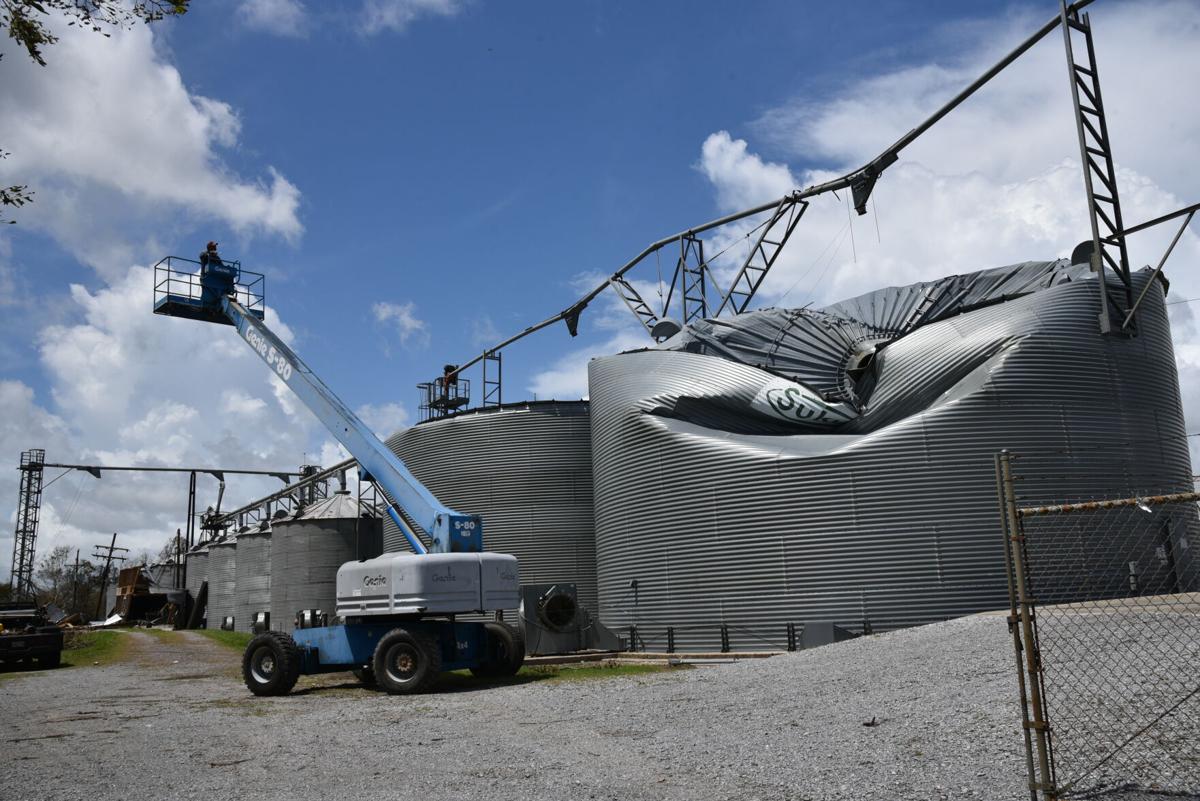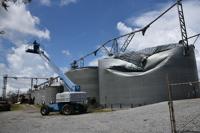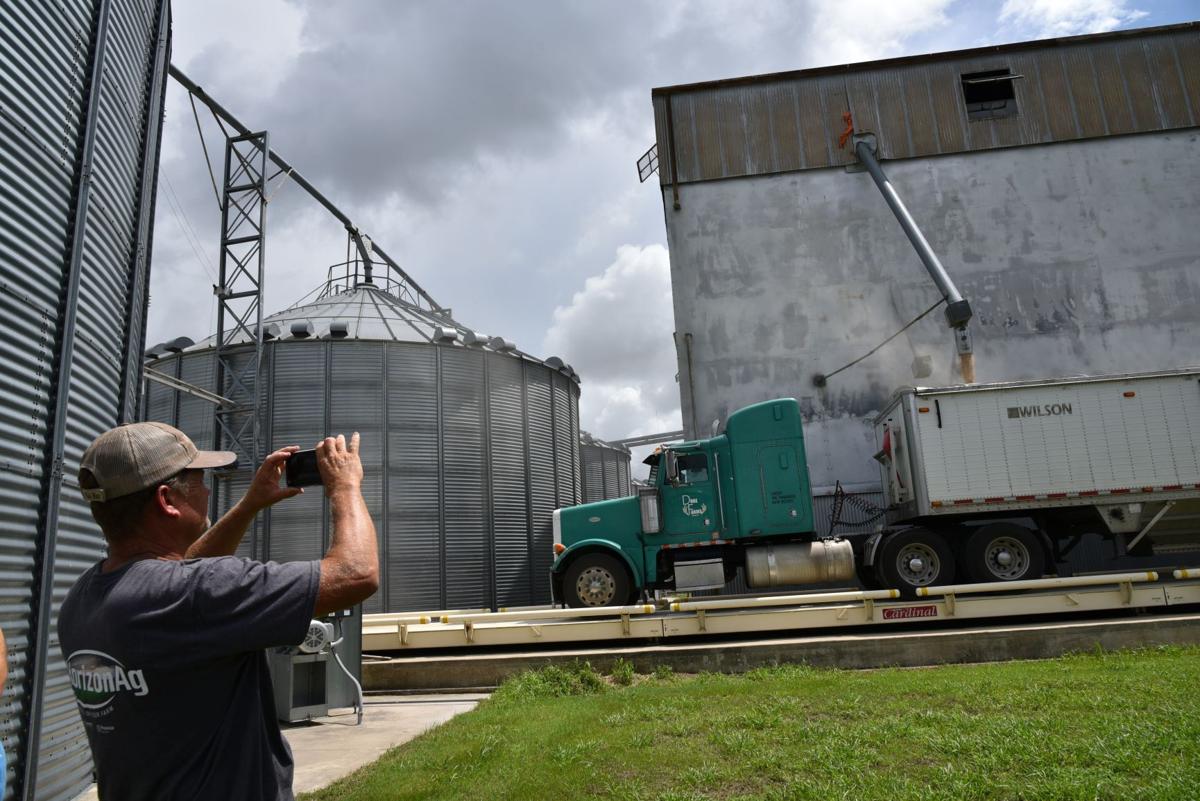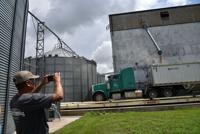Hurricane Laura takes toll on rice crop by damaging storage facilities, driers, transfer systems
- BY TIMOTHY BOONE | STAFF WRITER
- 3 min to read
A worker from the Supreme Rice Mill uses a lift to inspect a set of bins owned by Sweet Lake Land Co. of Calcasieu Parish that were damaged by Hurricane Laura. Farmers scrambled to get much of their rice crop harvested ahead of the storm, but damage to storage facilities, driers and transfer systems across the region are threatening their harvest.
- PHOTO BY BRUCE SCHULTZ / LSU AGCENTER
Farmer Paul Johnson photographs a load of his rice leaving a dryer at Thornwell. Hurricane Laura blew some of the building’s roof off, exposing his rice. Johnson is moving his grain from inside the structure to prevent it from spoiling.
- PHOTO BY BRUCE SCHULTZ / LSU AGCENTER
Southwest Louisiana rice farmers hustled and helped each other get their crops harvested before Hurricane Laura hit the state last week, but much of that hard work may have gone for naught.
The devastating storm hit rice storage facilities and driers, exposing the crop to rain.
“It’s frustrating, to be perfectly honest,” said Paul Johnson, a rice farmer from the Jefferson Davis Parish community of Thornwell. “This year has gone really well, with a great growing season, a dry harvest and good yields.”
Johnson wrapped up his harvest about two weeks ago and was feeling pretty safe because his crops were in storage and in the process of being dried. “You always feel you have it, once the crop goes in the bins,” he said.
But Laura damaged the roof at one facility, allowing rainwater to come into contact with the 2.9 million pounds of Jazzman rice he had harvested. At a separate facility, where Johnson had about 4.8 million pounds of rice, the transfer system was destroyed, meaning that there’s no way to get the rice out of the bin.
“There’s no way to move it,” he said.
Right now, Johnson said he’s trying to save as much of his wet crop as possible. If he can salvage 75% of the crop, he said he will feel good about it. He’s getting help from the Supreme Rice Mill in Crowley, which has put the rice it had in storage onto a barge, in order to provide drying space for farmers like Johnson.
“At this point, it’s all about small victories,” he said.
Dustin Harrell, a rice specialist with the LSU AgCenter, said farmers managed to harvest 95% of the first rice crop in advance of Laura. Now they’re dealing with drying facilities that don’t have roofs, damaged transfer systems and no electricity to power rice driers.
Harrell said he spoke to one farmer who had about 4 million pounds of specialty rice exposed to the weather. The farmer put the value of those crops at $712,000.
This year’s rice crop was shaping up to be one of the best in the past six years, Harrell said. It was on track to have the second-highest yield ever, with a high-quality crop.
“Now, this changes everything,” he said. “One day can change everything.”
While 75% of Louisiana’s rice crop is grown in the southwestern part of the state, about 25% is harvested in the northeastern part of the state. While as much as 95% of the crop had been harvested in Acadia Parish, for example, only about 5% of the crop had been harvested in the northern part of the state, Harrell said.
One Morehouse Parish rice farmer flew over his 50,000 acres of farmland and estimates that 30% of his crop was knocked over, Harrell said.
Sugar cane also was knocked over by Laura. Jim Simon, general manager of the American Sugar Cane League, which represents Louisiana sugar cane growers and processors, said despite all of the stalks of cane that got knocked over, the crop came out of Laura “much, much better shape than we anticipated.”
“If we have a nice, dry harvest season, the impact of the hurricane will be minimal,” he said.
Because sugar cane is a hearty, tropical plant, it’s easy for the crop to right itself.
“Crooked stalks, the harvesters pick that up pretty easily,” Simon said.
In the southern parts of Vermilion and St. Mary parishes, some sugar cane fields were inundated with water from the Gulf. Farmers are working to get the water out of the fields and clean up marsh debris. The good thing is there’s a lot less of this and a lot less debris than what was generated by Hurricane Rita, which struck the same area 15 years ago.
Right now, about 480,000 acres of sugar cane have been planted in Louisiana.
“We expect to harvest close to a record number of acres in Louisiana this year,” Simon said.
David Moseley, a soybean specialist with the AgCenter, said the state’s crop “looks OK” in the aftermath of Laura. The biggest issue is lodging, when plants are leaning to some degree. About 61% of the 1 million acres of soybeans planted in Louisiana has been harvested, according to the U.S. Department of Agriculture.
Even if crops are leaning, Moseley said, they will still be harvested. The problem is that farmers won’t be able to harvest all of their beans. And if the soybean pods end up sitting in water, that could be devastating, he said.
“If everything works right, we shouldn’t see too much in the way of problems,” Moseley said. “But if there’s too much rain, there will be more flooding.”https://www.theadvocate.com/baton_rouge/news/business/article_11b6211a-ec7e-11ea-be64-3748b17f43e3.html





No comments:
Post a Comment